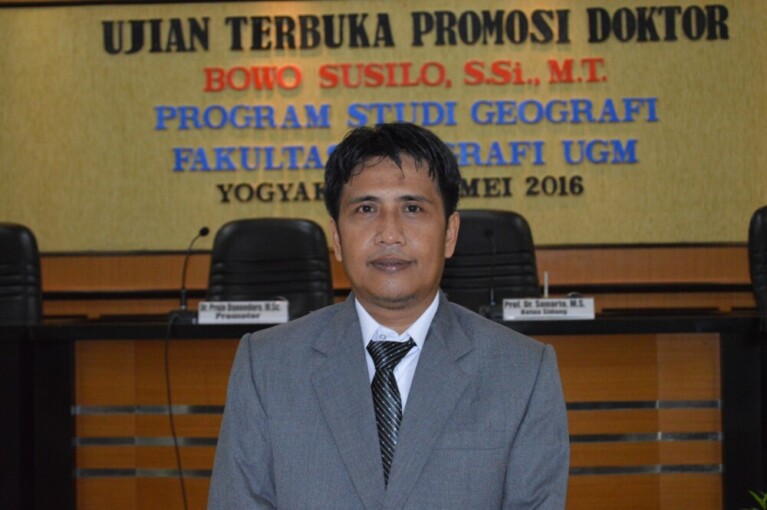
The dynamics of land use is an important study as it relates to human living basic aspects. One study focus on the dynamics is to understand the mechanism of the change in land use.
“Study on the complex spatial phenomenon requires a certain approach and method, one of these is spatial modeling,” said Bowo Susilo, S.Si., M.T, in the Merapi Auditorium, Faculty of Geography UGM on Saturday (14/5) to earn his his doctoral degree in Geography Sciences.
Bowo Susilo said to set up the spatial model of the dynamics of land use requires several aspects related to didactic dan heuristic aspects of the model, spatial dimension aspect and aspects related to predictive function.
“The model has to function as an assisting tool to make spatial predictions of land use change. Predictive function is a state-of-the-art spatial modelling of the dynamics of land use,” he said.
According to the lecturer in Faculty of Geography UGM, the study on the dynamics of land use can essentially be done in any area, taking into accounts two things, supply of spatial data and indication of significant change in land use.
Yogyakarta as a research area meets the requirement for study. BPS data showed significant changes in the area in the last 25 years (years 1980-2005).
“The percentage of agricultural land that is converted into non-agricultural land ranges between 17.5 – 27 percent. Through spatial modelling, this change can be studied and made the basis for prediction of possible changes in the future,” he said.
Defending his dissertation titled Spatial Modelling of the Dynamics of Land Use in Urban Yogyakarta Area, Bowo Susilo said that the total size of land use in Yogyakarta period 1993-2000 was 704.8 hectares. Changes occured in seven forms with different sizes ranging between 0.2 ha and 359.8 ha.
The dominant change is paddy fields becoming residential settlement, comprising 359.8 ha. Between years 2000-2007 the total change size was 755.7 ha with fifteen forms of changes ranging between 0.5 ha and 365.5 ha.
“The most dominant change is in the form of paddy fields that became residential settlement measuring 365.5 ha, and change forms of land use are varied. If simplified, it is into two categories, permanent and non- permanent,” he said, accompanied by promoter, Dr. Projo Danoedoro, M.Sc , and co-promoter, Prof. Dr. Hartono, DEA., DESS and Prof. Dr. R. Rijanta, M.Sc.
Bowo Susilo affirmed the determinant of land use corresponds to change in land use. Logistical regression analysis showed the significant relations between the size and quantity of change in land use with number of population and economic growth.
The research also produced a conceptual model to explain the mechanism for the land use change. Meanwhile, change in land happens due to three fundamental elements: demand for land, spatial preference and spatial calculation.


